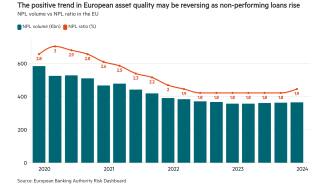The new law governing Portuguese covered bonds was enacted in March 2006 after a period of extensive consultation with the main market participants, aiming at creating a Portuguese model based on the best practices of established European covered bond legislation.
As in most jurisdictions, the Portuguese legislation allows for the issuance of two forms of covered bonds, mortgage-covered bonds (obrigações hipotecárias) and public sector covered bonds (obrigações sobre o sector público), on which the collateral is credits to, or guaranteed by central or local governments in an EU member state. Both forms of bond may be issued either directly out of the originator’s balance sheet or through a dedicated issuing bank. The direct issuance alternative has, so far, been the elected route of Portuguese banks because it combines the same investor protection features with increased administrative and cost efficiency.
Remote from insolvency
The Portuguese covered bond law grants covered bondholders a special preferential claim over all the assets in the cover pool, which are fully segregated by means of registry in separate accounts of the issuer and hence not available to meet any other issuer obligations until all amounts due to the covered bondholders have been fully paid.
The legal framework of Portuguese covered bonds supersedes the general bankruptcy law in Portugal, allowing for the full segregation of the cover pool assets from the insolvency estate of the covered bonds’ issuer, making the cover pool assets and the covered bonds insolvency-remote. If the issuer becomes insolvent, unless otherwise decided by a majority of two-thirds of all covered bondholders, the continuity of all outstanding covered bonds would be assured through the appointment – approved or made by the Bank of Portugal – of a financial institution to segregate and manage the cover pool assets for the benefit of the covered bondholders and to continue making timely payment of the amounts due on the bonds.
Strong credit protection
In the case of obrigações hipotecárias, the collateral comprises performing loans secured by first ranking (and lower ranking if all the higher ranking are also included in the cover pool) residential or commercial mortgages backed by real estate located in any EU member state. These mortgage loans are only eligible as collateral if they have a loan-to-value (LTV) of no more than 80% in the case of residential mortgages and 60% for commercial mortgages.
Mortgage loans that become more than 90 days overdue and/or no longer meet the LTV requirements must be replaced, which makes for additional credit protection to the covered bondholders.
Another feature that provides enhanced credit protection is the legally required over-collateralisation for obrigações hipotecárias. According to the law, the maximum number of bonds that may be issued at any time is limited to 95% of the outstanding cover asset pool, which translates into a 5.26% minimum over-collateralisation.
The legal framework lays out strict rules for the management of mismatches of the cover asset pool to its liability structure (that is, the outstanding covered bonds). As for interest rate risks and liquidity gaps, they must be continuously monitored and reported to the Bank of Portugal, which may impose adequate measures. To account for extreme scenarios, the assets in the cover pool must be stress-tested (accounting for hedges) on a net present value basis against a 200 basis points (bp) parallel shift of the yield curve. Additionally, any currency risk must be properly hedged.
Frequent property valuation
The subject of property valuation, a key driver of credit protection, is given a thorough approach in the regulation. For a mortgage loan to be eligible and included in the cover asset pool, a full valuation by an independent and qualified appraiser must have been carried out on the property at origination or subsequently.
Additionally, properties must be revalued regularly; at least annually in the case of commercial assets, and every third year in the case of residential assets. These revaluations may be conducted using a statistical model approved by the Bank of Portugal.
Supervision and reporting
Covered bonds’ issuance is closely monitored by the Bank of Portugal and subject to several specific pre-issuance and post-issuance information requirements from the issuer, including the cover pool register with all the segregated assets, and the asset and liability test on the cover asset pool.
The covered bond law further requires the appointment of a cover pool monitor and of a common representative. The former is an auditor, registered with the Portuguese Securities Commission (CMVM), acting for the benefit of covered bondholders and responsible for monitoring the issuer’s compliance with the legal and regulatory requirements. The latter, an entity similar to a trustee, represents the bondholders in aspects such as the exercise of their contractual rights and the execution of bondholders’ resolutions.
Portuguese covered bonds are compliant with the Capital Requirements directive and Undertakings for Collective Investments in Transferable Securities (UCITS) directive and, therefore, have been given a 10% risk weight by the Bank of Portugal.
Building a yield curve
The inaugural obrigações hipotecárias were launched by Caixa Geral de Depósitos (CGD), with the issue of a 10-year benchmark bond in November 2006, just after the secondary covered bond regulations were published by the Bank of Portugal. This had been a highly anticipated issue, as demonstrated by the overwhelming reception it was given by investors. As books opened, they rapidly attracted a strong bid, prompting CGD to close books earlier than planned due to the high level of oversubscription. Such strong demand allowed Caixa to tighten the issue spread by 1bp and increase its size to €2bn to correspond better to the level of oversubscription.
The deal was a groundbreaking success, attracting the participation of more than 130 investors from 23 countries worldwide.
On the back of investor-protection legislation and a sound Portuguese mortgage/housing market, Portuguese covered bonds have also benefited from scarcity value, with only six obrigações hipotecárias brought to the market so far.
CGD came to market again in June 2007 with a five-year benchmark issue that printed 2bp below mid-swaps, adding shape to its obrigações hipotecárias curve. The second issuer to venture into the covered bond market was Millennium bcp, with its inaugural 10-year issue, also in June 2007. Since then, Millennium bcp has steadily begun to build its own obrigações hipotecárias curve by issuing on two other occasions, with a seven-year in October 2007 and a two-year in April this year. In January, Banco Espírito Santo added its name to the list of Portuguese covered bond issuers by issuing a three-year obrigações hipotecárias .
The spreads at launch of the last three issues of obrigações hipotecárias, which braved the market in the credit crunch that began last summer, reflect the generalised widening of credit spreads across all jurisdictions of covered bonds. However, since the start of the credit crunch, Portuguese obrigações hipotecárias have been more resilient than those of jurisdictions such as Ireland, Spain and the UK.
Before last summer, in an environment of tight spreads, there was not such a distinct positioning between some of the covered bonds. The Spanish, Irish, Portuguese and the structured covered bonds traded at very close levels. However, the credit crunch has increased differentiation between jurisdictions, highlighting the differences between them in their credit factors and in the support offered by their national covered bond laws.
Positive prospects
Due to the advantage of issuing efficiently in large sizes and in a multitude of maturities, the obrigações hipotecárias should continue to be a funding instrument of choice for the larger Portuguese banks. At the same time, the relatively small dimension of the Portuguese banks and mortgage market should, nonetheless, maintain the obrigações hipotecárias as a scarce product.
Starting with CGD in November 2006, the Portuguese banks have so far preferred to set up obrigações hipotecárias programmes with the intention of bringing recurrent benchmark issues to the market and establishing a comprehensive and liquid yield curve. With the recent additions of Banco Santander Totta and Banco BPI, all the major Portuguese banks are now represented.
If market conditions permit, there could still be another round of benchmark issuance from the main Portuguese banks later this year. There are four obrigações hipotecárias in the pipeline: one from CGD and three inaugural issues by Banco BPI, Banco Santander Totta and Montepio Geral.
The first of the obrigações sobre o sector público have yet to hit the market but they could do so this year – CGD has already made public its intention to issue. However, due to the restricted stock of eligible assets in most Portuguese banks, this should be a scarce type of covered bond. As with the debut of obrigações hipotecárias, a favourable investor response to this product is anticipated because it would allow diversification into a new asset class in a new jurisdiction.
This article was supplied by the debt and structured finance team of CaixaBI.











